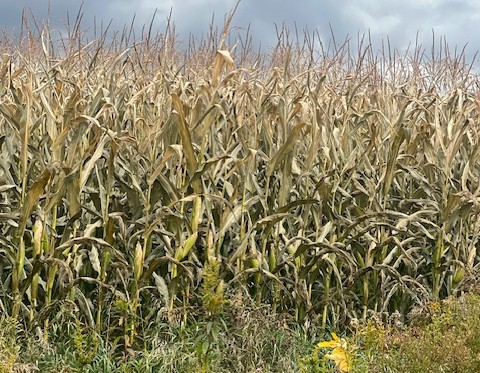Written by Heather Darby
Timely harvest of corn silage is one of the most critical factors affecting forage quality. To ensure maximum yields of dry matter, nutrients per acre, palatability, intake, and minimize storage losses corn should be harvested at 35-30 % dry matter. In most years, an early planting date and proper hybrid selection will allow for a timely harvest in the fall before freezing weather occurs. However, in some years like 2025 in which corn planting was delayed due to extremely wet weather, much of the corn in Vermont ends up still too immature going into the fall. The following article provides some suggestions in dealing with immature and frost damaged corn when chopped for silage.
When should immature corn be harvested?
After frost, immature corn will most likely be too low in dry matter content (high in moisture) for direct chopping. If possible, harvesting should be delayed until the plant is below 30 % dry matter. Harvesting the plant at low dry matter content will alter fermentation, increase silage runoff, and could potentially decrease feed intake. To avoid seepage losses and risk of undesirable fermentation, it will be necessary to allow the immature crop to stand in the field for several days following a frost for further drying.
Determining the moisture content of the crop after it is frosted can be tricky. After the plant is frosted, the leaves turn brown and give the appearance of rapid dry down. However, since most of the moisture is in the stalk and ear the plant will be at a lower dry matter than it appears. Most experienced farmers can estimate moisture contents for normal maturity crops but will likely underestimate the moisture content of an immature crop. Remember frozen immature corn will not dry down any faster than unfrozen corn. The only sure method to determine dry matter is to chop a small amount of the crop with the chopper and obtain a moisture determination (microwave method or Koster Tester) to know when the crop is nearing the desired 35 – 30 % dry matter. As a rule of thumb, whole plant moisture normally decreases by 0.5 % per day. Plant material of 30 % or slightly higher dry matter can be more effectively stored in a horizontal bunker or stack without excessive seepage losses than in an upright silo structure.
Under the best of conditions, preservatives and inoculants are generally not necessary for corn silage, however, this is a year to consider their use. Be sure and use proven products and follow the manufacturer’s directions.

How to store immature silage
Silage management practices are critical to harvesting and storing immature corn. Packing, covering, and particle size guidelines used in harvesting normal corn silage should be followed for immature corn silage. If possible, store immature corn separately from high quality corn silage. Very immature corn silage should be fed to animals with lower nutrient requirements.
Immature corn silage as a feed
Immature corn silage is a unique feed. Not surprisingly, immature corn can be expected to yield less silage. If the corn is at the dough stage it generally has anywhere from 65 – 85 % of normal silage yield. Slightly immature, frost damaged corn that has dented can still make good quality corn silage. As shown in Table 1, while yield is compromised the overall energy content is similar to more mature corn silage with kernels containing normal starch fill.
The decline in energy of slightly immature corn is not as great as one might expect because the stalk ADF and NDF is more available. The fiber (ADF and NDF) content of the plant will be higher but less lignified and therefore more digestible than in mature silage. In addition, the kernel texture and starch will be softer and more digestible. However, starch levels are likely to be lower.
After frost, if the leaf material is dead but the stalk and roots remain alive, there is a chance nitrates will accumulate in the lower stalk. Drought and frost stress combined increases the risk of nitrates accumulating in the corn. This can make the resulting silage dangerous for livestock. Increasing the cutting height will lower dry matter but increase silage quality since the lower stalk has the lowest digestibility and highest nitrate levels. To further manage this risk, ensile the crop for at least 21 days to reduce nitrate levels by 40-60% and test the silage for nitrates before feeding.
Field losses will increase with time, so producers need to balance harvest losses against fermentation loss and quality problems associated with wet silage. It will be essential to test forage made from immature corn as there will be a large variation from the nutrient content that might be expected. If you are going to feed a significant amount of this type of silage to lactating cows, it is worthwhile to obtain a fermentation analysis that includes silage pH, ammonia, titratable acidity, lactic, acetic, proprionic, butyric and isobutyric acids. Working closely with your nutritionist will help you develop the most useful rations with immature corn silage.
If you have questions or concerns about your corn, please contact the Northwest Crops and Soils office by calling (802) 656-7611 or emailing susan.brouillette@uvm.edu.
